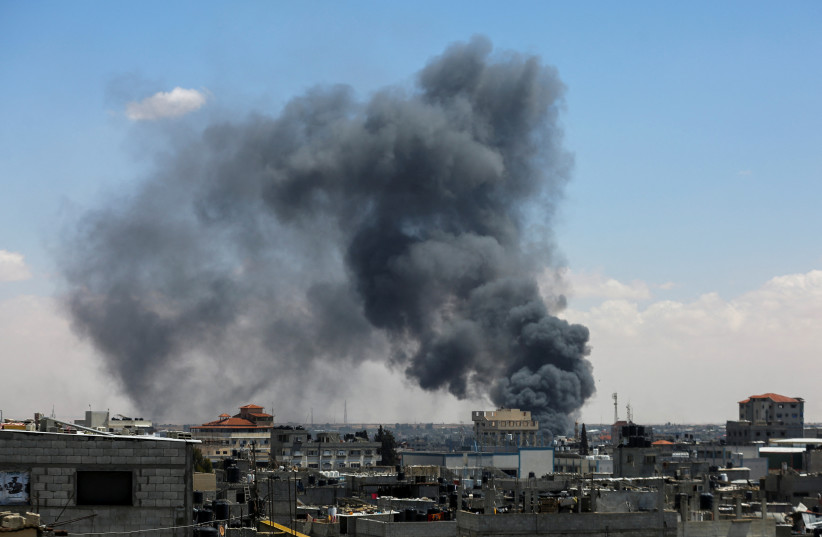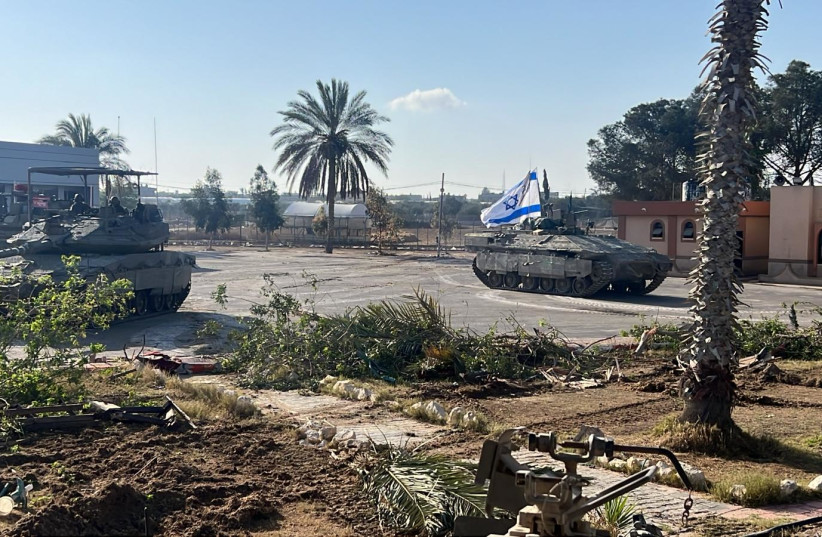From threats to action: Israel’s surprising move on the Rafah crossing
“The world must know, and Hamas leaders must know – If by Ramadan our hostages are not home, the fighting will continue everywhere, including the Rafah area,” National Unity Party minister Benny Gantz said.
Here’s the kicker: Gantz, a member of the war cabinet, spoke those words on February 18, about three weeks before the start of Ramadan.
Since that time there has been non-stop speculation about when, if, and how a Rafah incursion would take place – except it never did.
Hamas’ final stronghold
Until Tuesday morning, exactly seven months after the war began and a day after the IDF urged residents on the eastern side of Rafah to evacuate, troops moved in and quickly took over the Rafah crossing.
Gantz’s threat to go into Rafah was the first of dozens voiced by senior Israeli officials, foremost among them Prime Minister Benjamin Netanyahu, who issued menacing ultimatums over and over. The defeat of Hamas would not be complete, they said, if the IDF did not dismantle the three or four Hamas battalions left standing there, which had become Hamas’ final stronghold.

Each threat, however, would be met by stern warnings from the international community, led by the US, against such a move, at least until a feasible way could be found to move the civilian population – estimated at some 1.5 million people, the vast majority who were evacuated there from the northern and central parts of Gaza after the war began – out of harm’s way.
As time passed, it is now some 13 weeks since Gantz first issued his stern warning, Israel’s threats sounded increasingly hollow – and it is not good for the country’s deterrence posture if words are not followed up by action.
When Netanyahu reiterated the threat of a Rafah incursion again last week, telling a group of families of hostages and slain soldiers that Israel will go into Rafah to eliminate Hamas and achieve “total victory,” those who rolled their eyes as if to say “here we go again” could have been forgiven for their skepticism.
Yet early Tuesday morning the IDF delivered on the threats, though not in a way most expected.
First, it was not a massive incursion like those seen in the early stages of the war when the IDF moved into Gaza City or Khan Yunis. Rather, this was a limited, pinpointed action – one that proceeded with no IDF casualties and, according to the IDF, some 20 Hamas terrorists killed. The limited action indicates that Netanyahu is taking US President Joe Biden’s warnings against moving on the city seriously. According to various reports, the US last week – for the first time since the war began – withheld arms deliveries to Israel.
Secondly, the IDF’s warning to residents of eastern Rafah to evacuate created the impression that any IDF action would take place there. A quick action to take over the Palestinian side of the Rafah crossing, the sole crossing in and out of Gaza not in Israeli control, took some by surprise.
The move raises two questions: why now and does it matter?
Regarding the timing, two things prompted the move at this time. The first was Hamas’s apparent rejection over the weekend of the hostage deal that was on the table, a deal that US Secretary of State Antony Blinken only last week termed an “extraordinarily generous” offer by Israel.
Hamas’s failure to grasp that deal showed that the terrorist organization felt it was in the driver’s seat, that it could dictate terms. And this was not an irrational conclusion.
The IDF pressure on the organization had lessened significantly; Israel was coming under intense pressure from the international community to both not go into Rafah and to stop the war; and Netanyahu was facing noisy protests at home urging him to make a deal for the hostages at almost any price.

What was the rush, Hamas leaders reasonably concluded. Rather than take the deal, Hamas demonstrated an interest in dragging the negotiations out longer, likely reasoning that international and domestic pressure on Netanyahu would only increase and eventually he would fold.
Hamas’s rejection of this deal – one that included terms Israel had rejected earlier – showed that Israel had lost leverage and needed to regain the upper hand and apply pressure on Hamas head Yahya Sinwar. An incursion into Rafah would, according to this reasoning, do just that.
Apparently, this worked, because on Monday, just hours after the IDF instructed some 110,000 residents in eastern Rafah to evacuate the area, Hamas issued a statement saying that they accepted the deal.
Forget for a moment that the deal they accepted was not the one that Israel agreed upon, but the timing of their announcement made clear that they were paying attention to what the IDF was saying – this time via the notices to evacuate.
The second reason the move on Rafah began now had to do with the deadly mortar attack on Kerem Shalom that killed four soldiers and wounded 10 other Israelis on Sunday.
This attack, which came from Rafah, showed that Hamas remained a deadly threat there, and that if the Hamas battalions there were not dismantled, they would continue to fire on soldiers and communities in the western Negev.
If Israel wants people evacuated from those communities to move back into their homes, it cannot countenance these types of attacks. Furthermore, the nature of the attack – the number of mortars fired accurately – indicated not a spontaneous attack by isolated terrorists, but rather a coordinated attack by a unit working in an organized manner. That, too, is something that – post-October 7 – Israel can no longer tolerate.
As to whether taking over the Rafah crossing and raising the Israeli flag there matters, it does. It matters because this is one of the main symbols of Hamas’s civilian control of Gaza. Up until now, Israel has concentrated on dismantling Hamas’s military capabilities, overlooking the fact that the organization still asserts civilian control over the Strip and its residents.
From the Rafah crossing, Hamas was able to control what comes in and who goes out of Gaza. Anyone leaving Gaza for Egypt needs to go through the crossing, with Hamas reportedly extorting enormous sums from wealthy Gazans looking for a way out.
In addition, that crossing – over the years – has been the way both weapons and dual-purpose materials have been smuggled into Gaza. While Egypt has stopped some of the subterranean smuggling, Hamas has smuggled much of the weaponry that has come into the Strip by simply bribing Egyptian officials at the crossing.
The Israeli commander who yelled into his radio Tuesday morning after the IDF consolidated control over the area that “the Rafah crossing is in our hands” – echoing Motta Gur’s iconic cry after Israel captured the Old City of Jerusalem during the Six Day War that “the Temple Mount is in our hands” – may have exaggerated the importance of this particular military action. Nonetheless, it is not without significance, especially as it signifies that Israel’s threat to take over Rafah is real, even if it will be done piecemeal and over an extended period of time.
Hamas’s response in the coming days to the hostage deal that Israel agreed to – not the one that Hamas tried to alter – will indicate whether its leaders are paying attention.





Comments are closed.